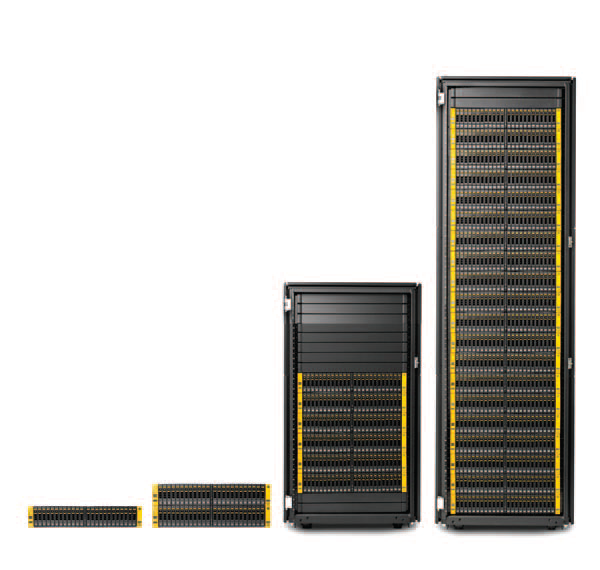HP 3PAR StoreServ 7000 - record breaker in mid-range performance

With the development of virtualization technologies, the provision of IT services as a service (ITaaS), as well as Big Data, changes in the load on storage systems have become nonlinear and unpredictable. At the same time, the data storage systems widely used today were designed and built taking into account the predictability and uniformity of the growth of loads. In the minds of engineers, growing loads could be structured and, therefore, effectively managed. In fact, the architecture of most of today's storage systems is based on ideas 15-20 years old. That is why very often they do not meet the requirements of today. Disk arrays based on various RAID options are loaded on average by 40%. The remaining performance margin is practically not used, and even such advanced technologies as Thin Provisioning and deduplication can only partially reduce the performance loss from deficiencies in the architecture of arrays.
At the same time, it is expected that already in 2014, up to 70% of the workload on the servers will fall on the virtual machines running on them. Traditional disk arrays, focused on working with predictable loads from applications will not be able to provide the desired speed of reaction and autonomy in accordance with the changing requirements.
In addition, the rapid development of data storage technology on solid-state drives (SSD) threatens to completely eliminate many practices in the field of data storage, created over the past twenty to thirty years.
')
Against this background, the new HP 3PAR StoreServ 7000 storage system is able to become the “gold standard”, to set the vector for the development of data storage technologies, ensuring the advanced performance and reliability of hi-end systems in the middle price segment available for a much larger number of enterprises.
- Autonomy: up to 90% reduction in time spent on managing the system - the reaction to new loads occurs automatically and instantly.
- Efficiency: up to 50% gain in capacity due to hardware organization of thin volumes and data ranking.
- Fault tolerance: four disk controllers, multi-user architecture, double the density of virtual machines in mixed boot mode.
- Perspective: a unified architecture and HP Peer Motion technology for a virtually infinite increase in data storage volumes, from SMB to Enterprise.
The basis of the 3PAR StoreServ 7000 line is two models, the 3PAR StoreServ 7200 and 3PAR StoreServ 7400. The first one is equipped with two disk controllers, and the second one can optionally be two or four. A large amount of cache is immediately delivered to the array controllers: 24 GB for the StoreServ 7200 and 32 GB for the StoreServ 7400. In addition to two Intel processors, each supervisor array has a unique, fast ASIC Gen4 processor that allows you to optimize the data stored on the fly. You can install SSD, SAS and SATA SFF (2.5 inches) and LFF (3.5 inches) form factors into disk shelves, and different types of disks of the same form factor can work together in the same shelf. At the same time, the performance of the controllers does not become a bottleneck when using high-performance SSD disks: the average throughput is 2.5 GB per second per disk for the 3PAR StoreServ 7200 and 4.8 GB for the 3PAR StoreServ 7400. At the same time, the average configuration IOPS ( input-output operations per second is 150.000 and 320.000 respectively.


3PAR StoreServ 7200 3PAR StoreServ 7400
Four 8-gigabit FiberChannel ports are already built into the system, and their total number can be expanded to 12 in the case of 3PAR StoreServ 7200 and 24 for 3PAR StoreServ 7400. You can also optionally install FCoE or iSCSI ports, 4 in 3PAR StoreServ 7200 or 8 in 3PAR StoreServ 7400.
The system package includes a software package for replication, data optimization, security management, and system reporting. There are also software tools for working with common virtualization tools and databases, including VMWare, MS SQL, Oracle and MS Exchange.
An additional advantage of the 3PAR StoreServ 7000 is the transparent and “painless” translation of the existing infrastructure built on the HP EVA storage system to the 3PAR StoreServ 7000. The data import process is extremely simplified and automated, which allows you to quickly and easily switch to the new generation of storage systems.
Today, the HP EVA and 3PAR F200 / 400 systems are included in the average storage segment in terms of price and performance. In 2013, 3PAR StoreServ 7000 will break into it, as a data storage system that has all the best features of EVA and has the best performance in the classroom.
By the way ...
An array of 3PAR StoreServ 7400 in four - controller configuration - this is actually the architecture and functionality of the “High-End array at the price of an array of the class midrange”.
One of the architectural features of disk arrays is that each logical volume is served by all array controllers that run in an active-active cluster. So, in a 4-controller system, if one controller falls, we lose no more than a quarter of the performance, but the most important thing is that the cache is re-mirrored between the remaining 3 controllers.
This is a fundamental difference compared to any arrays of competitors of the midrange class, in which a logical volume is served by a pair of controllers. And the fall of the controller 1 causes the cache to shut down — a severe loss of performance, or, if the cache does not turn off, the risk of losing data.
Material:
1. Quickspecks: h18004.www1.hp.com/products/quickspecs/14433_div/14433_div.PDF
2. 3PAR StoreServ ChalkTalk video: www.youtube.com/watch?v=0Y4t5Bt6GEI
UPD: SPC-1 released for the hP 3PAR 7400 array: www.storageperformance.org/benchmark_results_files/SPC-1/HP/A00134_HP-3PAR_StoreServ-7400-SSDs/a00134_HP-3PAR_StoreServ-7400-SSDs_CEP
Performance indicators: 258078 IOPS, the cost of an I / O operation is $ 0.58, with a high utilization of the array — 70.5% and a delay of no more than 1 ms.
Source: https://habr.com/ru/post/161273/
All Articles